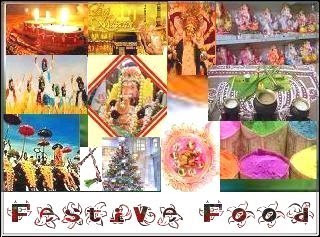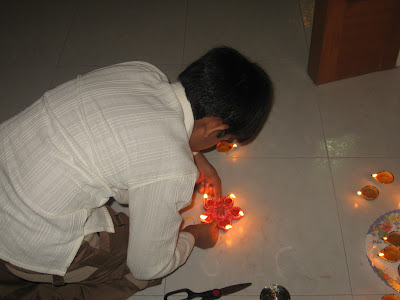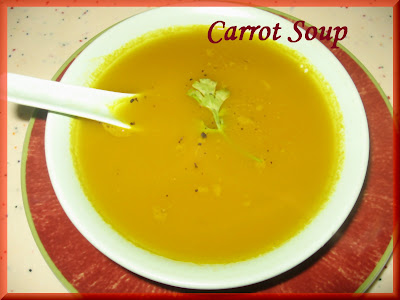After
Rakhi, Krishna and Ganesh Chaturthi, Onam and Navaratri celebrations, here Festive Food is back with
Diwali Celebrations.

Diwali, or Deepavali, (also called Tihar and Swanti in Nepal) is a major Indian and Nepalese festival, and a significant festival in Hinduism, Sikhism and Jainism. Many legends are associated with Diwali. Today it is celebrated by Hindus, Jains and Sikhs across the globe as the "Festival of Light," where the lights or lamps signify victory of good over the evil within every human being.
The festival marks the victory of good over evil, and uplifting of spiritual darkness. Symbolically it marks the homecoming of goodwill and faith after an absence, as suggested by the Ramayana.
In many parts of India, it is the homecoming of King Rama of Ayodhya after a 14-year exile in the forest. The people of Ayodhya (the capital of his kingdom) welcomed Rama by lighting rows (avali) of lamps (deepa), thus its name, Deepawali, or simply shortened as Diwali. Southern India marks it as the day Lord Krishna defeated the demon Narakasura. In western India it is also in honor of the day King Bali went to rule the nether-world by the order of Vishnu.
In Jainism it marks the nirvana of Lord Mahavira, which occurred on October 15, 527 BCE. The Sikhs celebrate Diwali for a different reason; on this day, the Sixth Guru, Guru Hargobind Ji, was freed from imprisonment along with 52 Hindu Kings (political prisoners) whom he had arranged to be released as well. after his release he went to Darbar Sahib (golden temple) in the holy city of Amritsar. There, he was greeted by Sikhs and many other people. In happiness they lit candles and diyas to greet the Guru. In India, Diwali is now considered to be a national festival, and the aesthetic aspect of the festival is enjoyed by most Indians regardless of faith.
Diwali is celebrated on the first day of the lunar Kartika month, which comes in the month of October or November.
The six days
Diwali celebrations are spread over six days in some of North India and Nepal. All the days except Diwali are named according to their designation in the Hindu calendar.
1.
Vasu Baras: Baras means 12th day and vasu means cow. On this day cow and calf is worshipped. Since it is believed that cow is symbol of God, Diwali is begun by worshipping cow and calf.
2.
Dhanatrayodashi or Dhan teras: Dhan means "wealth" and Trayodashi means "13th day". Thus, as the name implies, this day falls on the 13th day of the second half of the lunar month. It is an auspicious day for shopping of utensils and gold.This day is also regarded as the Jayanti of God Dhanvantri who came out during the churning of the great ocean by the gods and the demons. Dhanvantri Jayanti.
3.
Naraka Chaturdashi: Chaturdashi is the fourteenth day on which demon Narakasura was killed. It signifies the victory of good over evil and light over darkness (Gujarati: Kali Chaudas).
In south India, this is the actual day of festivities. Hindus wake up way before dawn as early as 2:00 in the morning, have a fragrant oil bath and wear new clothes. They light small lamps all around the house and draw elaborate kolams /rangolis outside their homes. They perform a special puja with offerings to Lord Sri Krishna or Lord Sri Vishnu, as he liberated the world from the demon Narakasura on this day. It is believed that taking a bath before sunrise, when the stars are still visible in the sky is equivalent to taking a bath in the holy Ganges.
After the puja, children burst firecrackers heralding the defeat of the demon. As this is a day of rejoicing, many will have very elaborate breakfasts and lunches and meet family and friends. In the evening, lamps are again lit and Goddess Lakshmi is worshipped and offered special dishes. This being a no moon day, many will offer special tarpana (offerings of water and sesame seeds) to their ancestors. This day is also called as Roop Chaturdashi.
4.
Lakshmi Puja: Lakshmi Puja marks the most important day of Diwali celebrations. Hindu homes worship Lakshmi, the goddess of wealth, and Ganesh, the God of auspicious beginnings, and then light lamps all across the streets and homes to welcome prosperity and wellbeing.
5.
Govardhan Puja: Also called Annakut, is celebrated as the day Krishna defeated Indra. Lord Krishna taught people to worship nature, as mountains bring rains to earth. That was the reason to stop worshiping Indra. His was the message that we should take care of our nature. For Annakut a mountain of food is decorated symbolizing Govardhan mountain lifted by Lord Krishna. In Maharashtra it is celebrated as Padva or BaliPratipada. The day commemorates King Bali. Men present gifts to their wives on this day.In Gujarat, it is celebrated as New Year, as Vikram Samvat starts on this day.
6.
Bhaiduj: on this day, brothers and sisters meet to express their love and affection for each other (Gujarati: Bhai Bij, Bengali: Bhai Phota). Most Indian festivals bring together families, Bhaiduj brings together married sisters and brothers, and is a significant festive day for them. This festival is ancient, and pre-dates '
Raksha Bandhan' another brother-sister festival celebrated in the present day.
Fireworks
To enhance the joy of Diwali both the young and the old light firecrackers and fireworks at night. Nowadays there is a significant growth in campaigns on creating awareness over the adverse impacts of noise and air pollution. Some Governments drive to keep the festival less noisy and pollution-free. The Tamil Nadu Pollution Control Board has banned production of crackers with noise levels of over 125 decibels. In survey of UP Pollution Control Board, it was revealed that the emission of smoke was found more in the light illuminating fire crackers. Levels of SO2 (Sulfur dioxide) found marginally higher on Diwali day.
Reference: Wiki
So join us and celebrate Diwali with Festive Food. Let’s enjoy the joy and fun of Diwali together.
 Guidelines for Celebrating Festive Food: Diwali Celebration
Guidelines for Celebrating Festive Food: Diwali Celebration
1. Diwali is celebrated in all parts of India in different ways and by preparing special goodies on this occasion. Here’s a chance to revive olden days.
Prepare a dish, which as a custom is prepared in your house. It can be anything sweet dish, any main dish, savoury snack……list goes on. Share with us how
Diwali is celebrated in your region or house and also any
special memories you have associated with Diwali. One can post hand made
Diya/lamp,
Rangoli or even any
special decorative items you have purchased/made.
2. The last date for sending your entry is
6th November 2008. We don’t want participants to prepare dishes for this event specially. Our idea is participants should send entries with the dishes, which they have actually prepared on Diwali and share with us their experience and enjoy the festival to the fullest.
3. Bloggers please add a link back to this event announcement. We would be glad if you can include Diwali colourful Logo. There are no restrictions on the number of entries.
4. Send in your entries at
Indian.festivefood@gmail.com with below mentioned information with subject
FF: Diwali or FF: Diwali Celebration.
* Name:
* Dish Name:
* Blog’s Name:
* Blog URL:
* Post URL:
*Picture: Please attach the picture(s)
5. Non Bloggers no need to get upset, email your recipe along with the picture. We will post it on your name and include it in the round up.
6. Old post are accepted, provided they are republished by linking back this event announcement along with the logo.
Wish you all Happy and Prosperous Diwali.






























